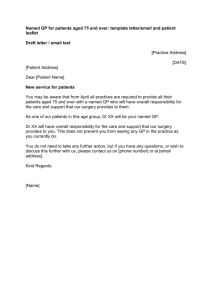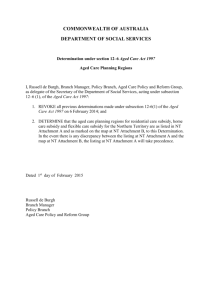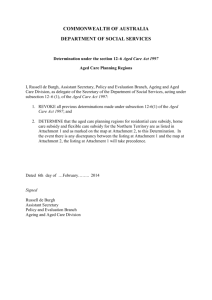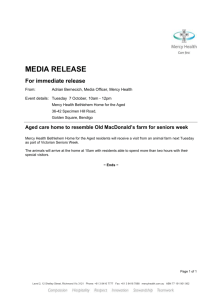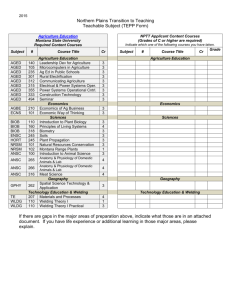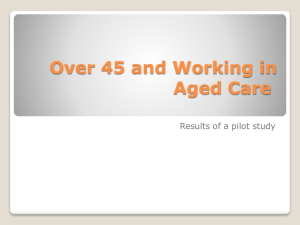Memorandum of Understanding
advertisement
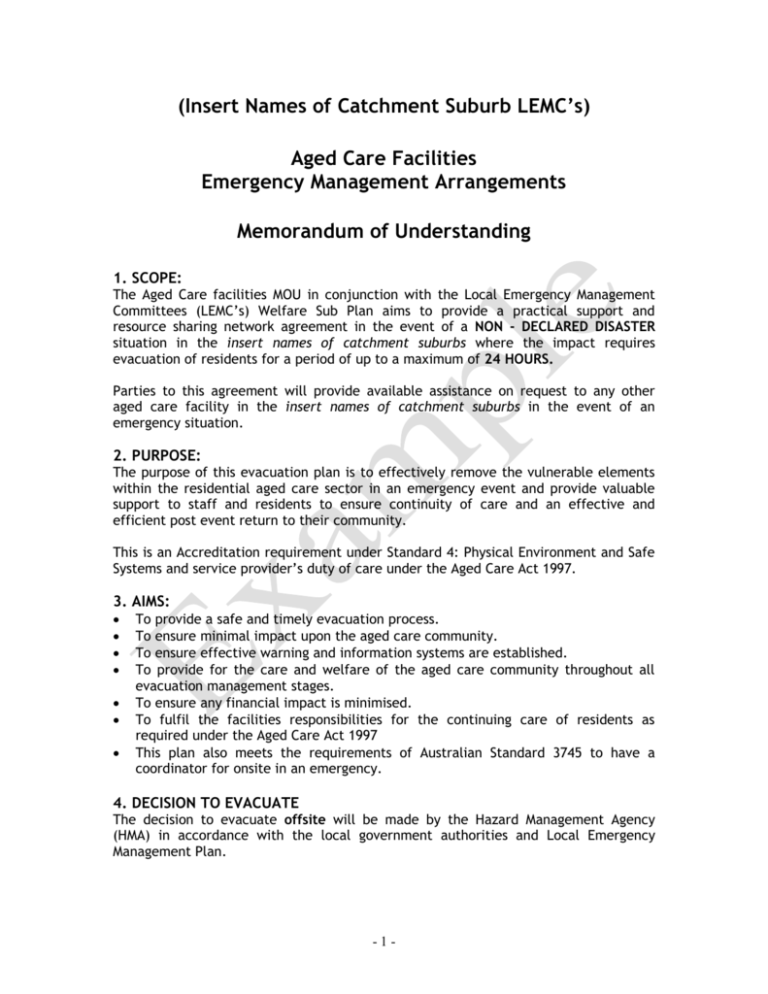
(Insert Names of Catchment Suburb LEMC’s) Aged Care Facilities Emergency Management Arrangements Memorandum of Understanding 1. SCOPE: The Aged Care facilities MOU in conjunction with the Local Emergency Management Committees (LEMC’s) Welfare Sub Plan aims to provide a practical support and resource sharing network agreement in the event of a NON - DECLARED DISASTER situation in the insert names of catchment suburbs where the impact requires evacuation of residents for a period of up to a maximum of 24 HOURS. Parties to this agreement will provide available assistance on request to any other aged care facility in the insert names of catchment suburbs in the event of an emergency situation. 2. PURPOSE: The purpose of this evacuation plan is to effectively remove the vulnerable elements within the residential aged care sector in an emergency event and provide valuable support to staff and residents to ensure continuity of care and an effective and efficient post event return to their community. This is an Accreditation requirement under Standard 4: Physical Environment and Safe Systems and service provider’s duty of care under the Aged Care Act 1997. 3. AIMS: To provide a safe and timely evacuation process. To ensure minimal impact upon the aged care community. To ensure effective warning and information systems are established. To provide for the care and welfare of the aged care community throughout all evacuation management stages. To ensure any financial impact is minimised. To fulfil the facilities responsibilities for the continuing care of residents as required under the Aged Care Act 1997 This plan also meets the requirements of Australian Standard 3745 to have a coordinator for onsite in an emergency. 4. DECISION TO EVACUATE The decision to evacuate offsite will be made by the Hazard Management Agency (HMA) in accordance with the local government authorities and Local Emergency Management Plan. -1- 5. IMPLEMENTATION OF THE AGED CARE EMERGENCY PLAN The decision to implement the Aged Care Emergency Arrangements in the event of an emergency that requires evacuation of residents from the facility will be made by the HMA and coordinated by the Incident Management Group (IMG). A representative of the aged care sector will be co-opted to the IMG for an emergency that involves local aged care facilities. 5.1. Financial arrangements 5.1.1 The State Department of Health and Commonwealth Department of Health and Ageing expect the aged care sector to manage the costs of an emergency situation within the subsidy income already provided. 5.1.2 Whilst some documented costs can be reimbursed by state agencies following an emergency or disaster event it is recognized that immediate access to some funds and the ability to recompense other facilities for their support is fundamental to this agreement, particularly for the items identified below: a) Ongoing Medical and Care Costs b) Stock level management and distribution Organisations to determine and maintain stock level requirements in the event of an emergency for up a maximum 24 hour period. Reimbursement of stock levels. c) Staffing Levels & RN’s The need to acquire additional staff and RN support from external agencies. d) Equipment and resources Parties to this agreement will provide cooperation and support by way of equipment and other resources as required and available to any other aged care facility in the local government authorities of insert names of catchment suburbs for the period required up to a maximum of 24 hours or as agreed at the time. 5.1.3 To recompense the costs above the following is the financial commitment for this agreement that: The costs of providing support for up to 12 hour period is met by charging a percentage of the RCS and total daily income for each person affected unless Category 8 in which case a pro rata of the daily bed fee applies. Aged Care organisations emergency contingency funding will be based on the following: 12 hours = 50% of RCS + total daily income x number of residents. 24 hours = 100% of RCS + total daily income x number of residents. 5.2 Documentation Financial recovery: 5.2.1 Documentary evidence will be required to obtain reimbursement from either state or other organisations in this agreement for support provided in an emergency situation 5.2.2 Sending facilities should ensure there is documentary evidence to support reimbursement claims. -2- 5.2.3 Receiving facilities will provide an invoice for reimbursement of costs based on the formula shown in 5.1.4 5.2.4 The actual costs and mechanisms for reimbursement from the state agencies in a State declared emergency requires further clarification but is not required for the purposes of this agreement. Evacuation and Recovery Management: 5.2.5 Documentation for use by aged care staff in an evacuation and recovery event is as contained in the ‘Procedure for Emergency Evacuation and Reception of Residents between Aged Care Facilities’ and will be reviewed following an event, exercise or every 2 years, whichever the first. Security of facilities 5.2.6 Following an evacuation the security of a facility that includes resident’s personal items will be the responsibility of the facility/organisation. It is likely that this type of emergency event expense is covered in business continuity and building/contents insurances and will be the responsibility of individual organisations to confirm with their insurer and incorporate their arrangements in their emergency management plans. 6 . Insurance 6.1 It is expected that the required insurance specification for the aged care sector covers for staff and residents being transferred to other facilities in the event of an emergency situation. The cover is provided via building and contents; workers compensation, business continuity, public liability and professional indemnity insurances. 7. Aged Care Facilities Network Resources Required and Available 7.1 For the purposes of this agreement support will be required for up to a 12 hour period (maximum 24 hours before becoming an accreditation issue) 7.2 The insert names of catchment suburbs LEMC’s will be provided with a list of local Aged Care facilities that are party to the MOU. Maintaining the database and issuing update to councils will on a 6 monthly basis and will be the responsibility of the areas Aged Care Emergency Network Group. 7.3 The database will include possible assistance in the event of a local emergency from local suppliers, sponsors and contractors. 8.Aged Care Facilities Emergency Plans ( link with 9) 8.1 Each facility will provide an instant Identification method, preferably as shown in the Aged Care Sector that includes critical health information on residents and identifies their facility. 8.2 Any staff provided by the sending facility will identify themselves on arrival at the receiving facility. 8.3. The sending facilities agree to release all necessary information below to the receiving facility to ensure continuity of care for residents and their carers. -3- a) Medical records b) Contact records, relatives, carers, GP’s informed 8.4 Each facility will make their own arrangements for the continuing care of residents during the 24 hour period and following a decision on non return to their facility. This could mean longer term transfer of residents between other facilities in and outside the City area. 9. Confidentiality Policy and Procedures 9.1 The Department of Health and Ageing will provide personal details of residents as required to the relevant agencies and emergency services in the event of an emergency. 9.2 Normal confidentiality procedures of the aged care sector will be maintained. 9.3 Control of public information available to the media will be redirected to the Police. 9.4 In the event of an offsite evacuation the Incident Management Group will determine the receiving facilities and liaise with the persons outlined in the Procedure for Emergency Evacuation and Reception of Residents between Aged Care Facilities. 10. Support for staff pre and post event 10.1 Facilities will determine their own process for debriefing and support of staff after an event and may request further assistance from the insert names of catchment suburbs recovery plan as required. 10.2 The insert names of catchment suburbs aged care network will undertake a debriefing and review of the plan after any event where the procedures have been activated. 11. Accreditation Requirements 11.1 The aged care sector is expected to fulfil their responsibilities for the continuing care of residents as required under the Aged Care Act 1997. These arrangements comply with ‘Social Leave’ criteria for up to a 24 hour period only and do not commit aged care organisations to longer term requirements for non return to facilities. 12. Testing the plan 12.1 The insert names of catchment suburbs Aged Care sector evacuation and reception procedures will be evaluated by the Aged Care Sector Network following a table top exercise to be held in March 2006 and a live exercise between facilities using volunteer evacuees in the following 6 months and thereafter on at least a two yearly basis. 13. Partners to the Memorandum of Understanding Appendix 1 -4- Appendix 1 Aged Care Sector Network contact list (last updated dd/mm/yy) Organisation Organisation Name Facilities Facility Name & Suburb Contact Numbers Contact Persons Primary Person Alternate Person Beds Available Transport available Empty beds available + 5 extra beds in activities area Bus 1xdisabled taking 3 wheelchairs + 6 seated persons 2 x 22 seats Bus transport available High Care Organisation Name Name & Suburb Low Care Organisation Name Name & Suburb Low Care Primary Person Alternate Person Primary Person Alternate Person -5- Empty beds + 10 extra beds in activities areas Empty beds + 3 extra beds in community centre Appendix 2 Emergency Management Plan structure State Emergency Plan Local Emergency Plan LEMC Response and Recovery Plan – (Incident Management Team) Welfare support Plan Welfare Liaison Coordinator Aged Care emergency plan Emergency Coordinator -6- The undersigned partner/s agree to the terms and conditions of this memorandum of understanding and commit to actively participating in this initiative. Active commitment includes identifying and providing a replacement representative of each organisation should the nominated representative no longer be available, including temporary absences. For and on behalf of ……………………………………………………………..… (Organisation) Authorized Person: ……………………………………………………………………… (Please print name) Signature: Date: ……………………………………………………………………… …………………………………………………………………….. -7-
